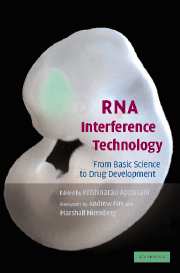Book contents
- Frontmatter
- Contents
- Foreword by Andrew Fire
- Foreword by Marshall Nirenberg
- List of Contributors
- Introduction
- Section one Basic RNAi, siRNA, microRNAs and gene-silencing mechanisms
- Section two Design, synthesis of siRNAs
- Section three Vector development and in vivo, in vitro and in ovo delivery methods
- Section four Gene silencing in model organisms
- Section five Drug target validation
- Section six Therapeutic and drug development
- 26 RNAi-mediated silencing of viral gene expression and replication
- 27 RNAi in drug development: Practical considerations
- 28 RNA interference studies in liver failure
- 29 RNAi applications in living animal systems
- Section seven High-throughput genome-wide RNAi analysis
- Index
- Plate section
- References
27 - RNAi in drug development: Practical considerations
Published online by Cambridge University Press: 31 July 2009
- Frontmatter
- Contents
- Foreword by Andrew Fire
- Foreword by Marshall Nirenberg
- List of Contributors
- Introduction
- Section one Basic RNAi, siRNA, microRNAs and gene-silencing mechanisms
- Section two Design, synthesis of siRNAs
- Section three Vector development and in vivo, in vitro and in ovo delivery methods
- Section four Gene silencing in model organisms
- Section five Drug target validation
- Section six Therapeutic and drug development
- 26 RNAi-mediated silencing of viral gene expression and replication
- 27 RNAi in drug development: Practical considerations
- 28 RNA interference studies in liver failure
- 29 RNAi applications in living animal systems
- Section seven High-throughput genome-wide RNAi analysis
- Index
- Plate section
- References
Summary
Introduction
The development of pharmaceuticals is a complex process that requires a tremendous investment of human and financial resources. In the post-genomic era, drug development has traditionally followed an established protocol that begins with the identification of a new target, proceeds with the identification, optimization and clinical evaluation of small molecule inhibitors of that target and culminates with the successful launch of a new pharmaceutical entity (Figure 27.1). The estimated cost of bringing a new drug to the market place is approximately $900 million over an 8+ year timeframe. RNAi technology can be applied at multiple steps in the drug development process and has the potential to change the pattern of drug development altogether. Indeed, RNAi has been widely employed as a powerful target discovery and validation tool in vitro and is currently being applied in vivo for target validation using whole organisms. In addition several companies are pursuing the clinical development RNAi compounds for the treatment of various diseases.
Mediators of RNAi fall into two main categories: synthetic RNAi compounds, e.g. short interfering RNA (or siRNA) and Invitrogen's STEALTH RNAi™ compounds, that can be delivered exogenously; and RNAi molecules, e.g. short hairpin RNA, or shRNA, that are expressed endogenously from plasmid or viral vectors. Both of these formats have merits as well as limitations, and have application in cultured cells (in vitro) and in whole organisms (in vivo).
Information
- Type
- Chapter
- Information
- RNA Interference TechnologyFrom Basic Science to Drug Development, pp. 384 - 395Publisher: Cambridge University PressPrint publication year: 2005
